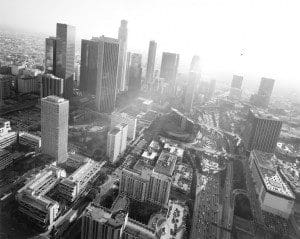
Twenty-five years or so ago, when I first started coming to Los Angeles on a regular basis, I used to stay with a friend who had a satellite’s eye view poster of the city in his breakfast room. It was then — and remains, I think — a vivid metaphor. Not for the sprawl of Southern California, although you can certainly see it there, but rather for the odd tension of the built environment, which can only push the natural landscape so far. If sprawl is an expression of our attempts to control our surroundings, the satellite photo reveals just how limited, how temporary, such interventions are. There is the basin and the San Fernando Valley, full of the flat gray outline of the city. And then there are the mountains and the desert, undeveloped and unforgiving, ringing it all in. I’ve lived in Southern California for two decades now, and I keep thinking about that poster and what it says. I even wrote about it in an essay I contributed to Michael Light’s new book LA Day/LA Night, a collection of large panoramic photographs of the city in the light and in the dark. Light is a San Francisco photographer in the midst of an extended project he calls Some Dry Space: An Inhabited West, which will ultimately fill “eight or ten published aerial ‘forays’”; LA Day/LA Night is foray number two. And while I’m wary of writing too much about a project I had a part in, I will say that it was precisely because of Light’s bigger vision, his sense of the relationship between the constructed and the natural, that I was drawn to want to participate in the book.
Light’s idea is that in the West, with its light, its open spaces, and its “enduring mythologies increasingly divorced from urban and suburban realities,” we confront our contradictions writ large. He’s absolutely right about that, and he illustrates the point by going up in a small plane (or, in the case of LA Day/LA Night, a helicopter) to shoot from the air. The pictures that emerge are formal, composed, but with an improvisational quality, as well. This, of course, is only as it should be, since what else is the West if not an extended improvisation, in which we build enormous markers — freeways, industrial plants, office towers — with the full knowledge that nature will one day take the landscape back. Such an opposition is embodied in the substance of the photographs, which often bleed off the edge of the page in a haze of refracted light. The night images go even further, blurring into ambiguity, in which the lights of the city blend into a kind of starlight, leaving us uncertain where Los Angeles ends and space begins.
Not long after I moved to Southern California, my friend with the poster packed it in and went back east. By then, I was so consumed with making sense of my daily life that I forgot about the long view. But that’s the thing about Los Angeles: There’s no way to forget for long. It’s the essence of the place, a city built on speed and celluloid, nurtured on stolen water and engineering, a creation of technology. We live here through sheer force of will; we live here through nature’s grace. “There it is. Take it,” William Mulholland said in 1913 at the opening ceremony for the California Aqueduct. He was talking about water, but nearly a century later, the same could be said about almost everything.
